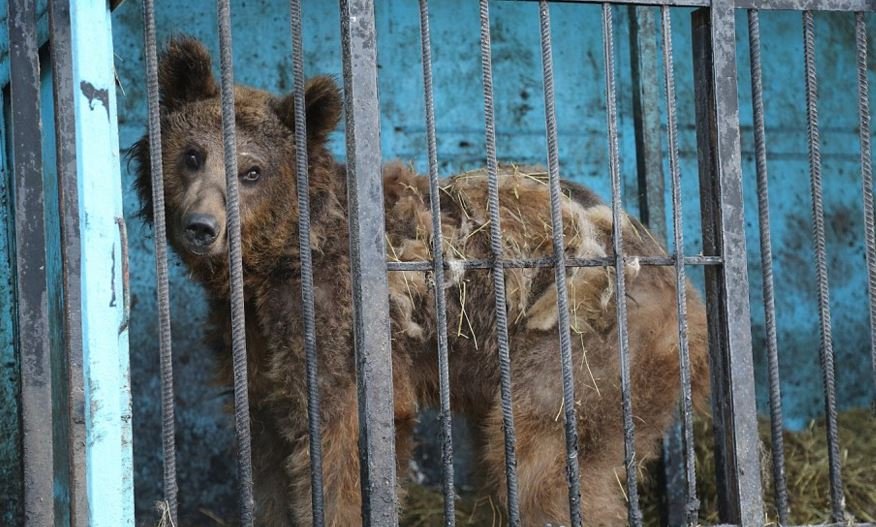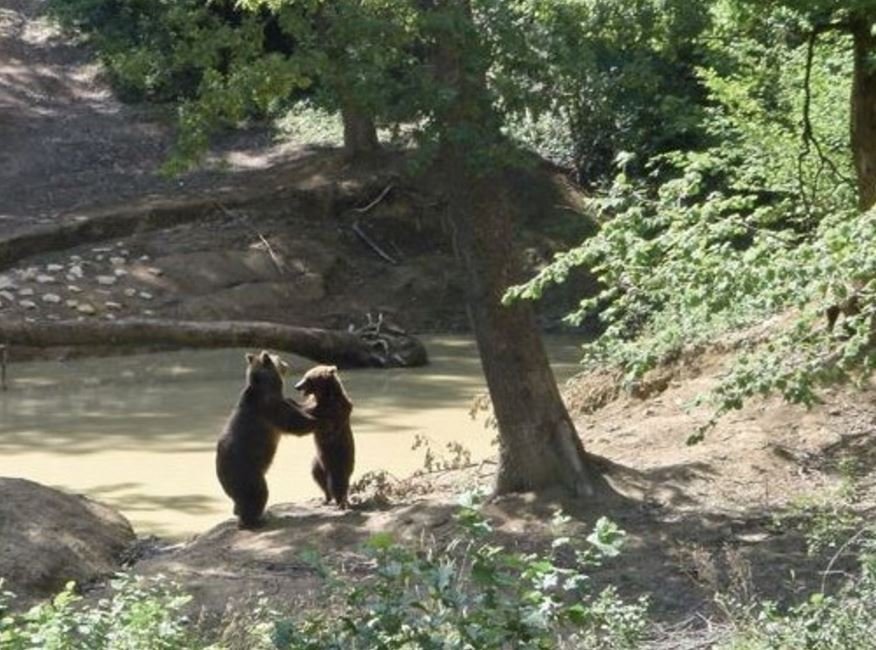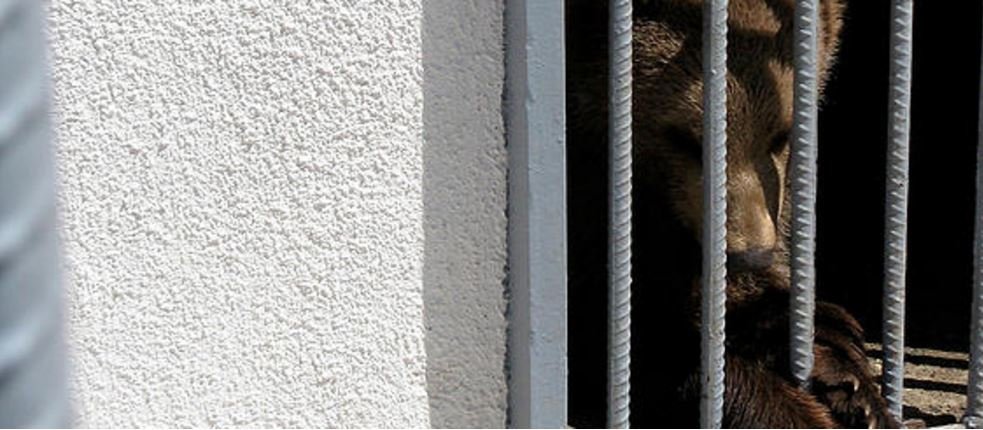Special for the Armenian Weekly
On Jan. 19, an article was published in a UK publication, the Daily Mail, claiming that “the world’s saddest zoo” is in Armenia. The story was about the Gyumri Zoo. The article quickly went viral due to the horrific pictures and story of the animals (three lions and two bears); the article indicated that the animals were starving and left to rot.

Sadly, the article neglected to mention that individuals and organizations in Armenia were in the process of rescuing the animals, the broader problem of private zoos in Armenia, and the legal complexities involved.
Timeline
In October 2015, the owner of the Gyumri Zoo, Stepan Vardanyan, announced that he was ill and could no longer care for the animals. Because there is no animal sanctuary in Armenia, the owner had asked the Yerevan Zoo, the only competent facility in Armenia equipped to care for the animals, to take them; however, his request was denied. Housing these animals takes an immense amount of resources and space, which the Yerevan Zoo does not have.
Animal advocate Silva Adamyan jumped straight into action and created the “SOS Gyumri Zoo Animals” Facebook group to get support. She contacted me for help since we had worked together in 2010 to close down the dolphinarium in Armenia. The role of the Armenian Environmental Network (AEN) as an organization is to build local capacity in Armenia and garner international support, which we did in 2010, and we jumped in again to help the Gyumri Zoo animals.
I reached out to my network, including all of the large international animal rescue organizations, to find a solution, and found an incredible sanctuary in Romania able to take the bears (Libearty Sanctuary) and an organization able to fund the relocation of the bears (Brigitte Bardot Foundation). I communicated this to the SOS Gyumri Zoo Animals Group and the Foundation for the Preservation of Wildlife and Cultural Assets (FPWC) since they have experience transporting wild animals. All of us began to prepare for the relocation of the bears (while still looking for a solution for the lions). The Brigitte Bardot Foundation (BBF) and a private donor provided funds for food, which dedicated volunteers in Gyumri purchased and took to the zoo. All in all, individuals and organizations from Armenia (Yerevan and Gyumri), France, Spain, and Romania were supporting the mission to rescue the bears and the lions.

Larger Issue
The issue is broader and more complicated than the Daily Mail article presents. Wild animals are taken from the wild or bred in captivity and kept in cages in many privately owned facilities in Armenia (zoos, restaurants, hotels, etc.) as an attraction. According to some estimates, there are more than 60 bears in captivity in private facilities in Armenia alone. Cubs are often given away as gifts or sold—not to mention the unknown numbers of “pet” wild cats and primates in Armenia. For the past few years, news sources have highlighted Armenia’s involvement in the primate trade and the display of primates in private parks in Armenia. This issue is not unique to Armenia and there are many exotic animal owners even in the United States.
Though the public in Armenia was aware of the situation in the Gyumri Zoo for years, tackling the problem is a huge challenge since there is currently no rehabilitation center or sanctuary in Armenia, the applicable laws are unclear, and the enforcement of the laws is extremely weak.
It’s not that individuals and organizations in Armenia did not care about the animals in Gyumri or did not try to help the situation before this time. For example, FPWC raised the issue in 2009 when they made a film about the Gyumri Zoo and have been working with the government on plans to build a bear sanctuary in Armenia to house bears confiscated from private facilities. AEN supported this initiative by creating a petition to the government to halt the display of bears in private facilities in Armenia and support efforts to find appropriate homes for the bears currently in captivity. Animal advocates in Armenia have also raised this issue repeatedly in the media.
Aftermath of the Daily Mail Article
Because the Daily Mail article implied that no one in Armenia was doing anything to help the animals, many individuals and international organizations saw the situation as “hopeless and urgent” and jumped in to help. Though help was obviously appreciated, it created a disorganized frenzy and actually threatened the work we had set in motion. Not all of our activities were made public and a lot of work was being done “behind the scenes” in order to respect the privacy of those involved and to keep the situation from becoming too publicized, which has impeded such rescue operations in other countries.

Although we were doing everything we could to help the animals, many concerned individuals from around the world sent aggressive e-mails and Facebook messages, and did not understand how difficult and delicate the process of rescuing and relocating five large wild animals is. There is sadly no quick and easy fix. This international pressure would have been much more beneficial had it been directed towards the Armenian government. What is needed is governmental action to shut down these private facilities and ensure the relocation of the animals to appropriate facilities, which does not happen overnight. As many are aware, it’s often the oligarchs with high-level connections that are the individuals guilty of buying, trading, selling, and displaying wild animals. Therefore, getting true government support is a huge battle. This issue should not be viewed as having a simple fix.
‘Although we were doing everything we could to help the animals, many concerned individuals from around the world sent aggressive e-mails and Facebook messages, and did not understand how difficult and delicate the process of rescuing and relocating five large wild animals is. There is sadly no quick and easy fix. This international pressure would have been much more beneficial had it been directed towards the Armenian government.’
The obvious bright side here is that more people are now aware of this issue in Armenia. Unfortunately, because of omissions in the Daily Mail article, not many people are aware that the Gyumri Zoo is just one of many such facilities displaying wild animals. This is a much larger problem than what many envision.
Update on the Gyumri Zoo Animals
As of right now, the bears are getting strong and healthy at the Yerevan Zoo while their transport cages are being prepared and flights arranged. The Libearty Bear Sanctuary, managed by the Millions of Friends Association, is the largest brown bear sanctuary in Europe. The bears will have a second chance at an amazing life there! Although the BBF had also committed to fund the relocation of the lions, a coalition of international and local organizations has stepped in to oversee and manage the rescue of the lions. The Ministry of Nature Protection of Armenia has established a government-supported Committee for the Protection of Captive Animals in Armenia to oversee the efforts and create limits and requirements for private zoos. FPWC is currently building a rescue and rehabilitation center for the lions and, like the bears, the lions will soon be moved so they can be rehabilitated before they are sent to a sanctuary. The committee is considering many potential sanctuaries to determine the best choice for the lions.
How to Help
There are many ways to help the initiative to stop the practice of keeping wild animals in privately owned facilities in Armenia:
– Sign the petition to the Armenian government encouraging officials to halt the capture of brown bears from the wild in Armenia.
– Report any caged wild animal you see in a private facility in Armenia to the Armenian Environmental Network.
– Support the Libearty Bear Sanctuary, which will be caring for the two bears from Gyumri for the rest of their lives.
– Support the efforts of FPWC to build a bear sanctuary in Armenia (indicate that your donation is for the bear sanctuary).
– Donate to WVS to help with the rehabilitation and relocation costs for the lions (indicate that your donation is for the Gyumri lions).
And as a general rule, never support a private establishment (zoo, restaurant, etc.) that displays wild animals in any country.
Keep yourself updated by following AEN’s Facebook page, at https://www.facebook.com/ArmenianEnvironmentalNetwork.
Serda Ozbenian is the executive director of the Armenian Environmental Network.


Animals are not ours to use or abuse for clothing, entertainment, food, etc. Humans are the root of all evil.
“Humans are the root of all evil.”
Agree.
You are human, therefore…..
I AGREE..most humans are evil, and self centered, but a small number are caring and conscientious, and they will help those animals sooner or later…this man made tragedy is so unnecessary and so heart breaking
No, humans are not the root of all evil. Clearly you have never heard of the Guinea worm, or countless other parasitic diseases. Or perhaps you are not familiar with viruses such as the one causing polio. What kind of self hate would have one think that humans were the root of all evil?
In general the Armenian population needs to be taught Vivo sense.that should start at Scholz with you.g kids. They are our only hope to get our country on the right foot toward a bright future.
As horrible as this may be, I hope someone can spare some compassion for the human animals of Gyumri who have suffered over 27 years of Days of Shame. https://www.youtube.com/watch?v=yUwYP14B2Vo
Perfect report with correct links and informations, we all hope that the rehabilitation centre agreed by WVS and FPWC could go ahead without any delay, and well done Serda
It breaks my heart.
I ask all the readers to pitch in a buck, a fin or a see-note to say the least.
A request to “never support a private establishment that displays wild animals” would be more credible and more useful if the requester actually named those oligarchs (or politicians, since some of them seem to like to be called that) in Armenia who have private zoos because “support” also means buying things from them or voting for them or worshiping in their churches.
Great point, Steve! There are efforts to create a database of known facilities with captive wild animals. We will surely call out the owners as well. If you know of any such facilities/oligarchs, please do email us.
JGinNJ // February 19, 2016 at 12:19 am //
“No, humans are not the root of all evil. Clearly you have never heard of the Guinea worm, or countless other parasitic diseases. Or perhaps you are not familiar with viruses such as the one causing polio. What kind of self hate would have one think that humans were the root of all evil?”
Diseases, parasites, or any other organisms cannot be considered evil as they are merely trying to feed themselves, survive, and reproduce. On the other hand, human beings trap, kill, and cage animals (and sometimes each other) for entertainment or greed, not necessity, making them evil.
Privately owned wild animals seems to be a global issue and not just a problem that appears in Armenia. In fact, lions, sharks and other animals are kept in hotels in Las Vegas and Dubai to simply attract and entertain guests and tourists. Others are drugged and kept in cages to serve as a photo props for western tourists in Thailand and many other Asian countries. In other words, the problem with trading wild animals and trophies is much larger than what it seems and we need to take action. We can stop visiting those facilities, hotels, restaurants and countries. We can speak up and explain why we ban such businesses. Only then then we have a chance to decreasing and stopping this injustice.
Stepan Vardanyan was the previous owner and director of that hell hole in the town of Gyumi, Armenia.
Mr. Aramayis Grigoryan, RA Minister of “Nature Protection!!!???”, ARMENIA:
YOUR TITLE DOES NOT REFLECT THE WAY BLACK BEARS ARE ABUSED IN ARMENIA.
Thanks to this WORLWIDE PETITION, the whole world knows about the way you mistreat brown bears.
THIS IS JUST A SMALL PIECE OF THE HUGE CORRUPTION CIRCLE THAT HAS ENGULFED ARMENIANS AND ARMENIA. QUICK FIXES ARE OK, YET NO PERMANENT SOLUTION AT SIGHT.
JGinNJ is wrong when he says humans are not the root of all evil. The Guinea worm is not consciously aware of the agony it causes. A whale playing with a seal, my dog shaking a rabbit to death, is not evil. Humans are the only creatures (on this planet anyway) who knowingly cause suffering. It is that knowledge that makes them evil.
I HATE HUMANS! I PRAY THAT EVERY HUMAN IS GONE & ANIMALS TAKE OVER! ANIMALS DON’T ACT THE WAY THAT PEOPLE DO. I AM NOT A PEOPLE PERSON FOR REASON. ANIMAL LOVER ONLY OTHER THEN MY FAMILY.
I’m confused. You claim to be a part of a process that started in 2009? So, the article was released in January of 2016 and the animals were in new sanctuaries 4 months later. The article did in 4 months what you couldn’t do in 7 years? Why were this poor elderly couple feeding these animals, if you were so involved? Sounds like you are just trying to cover up your ineptitude.